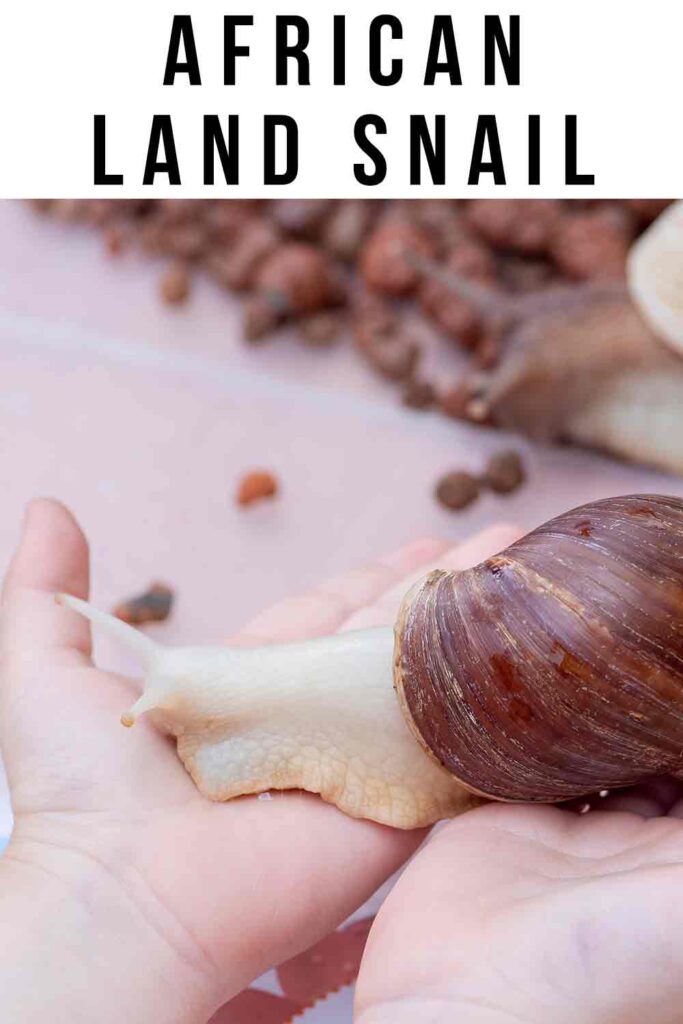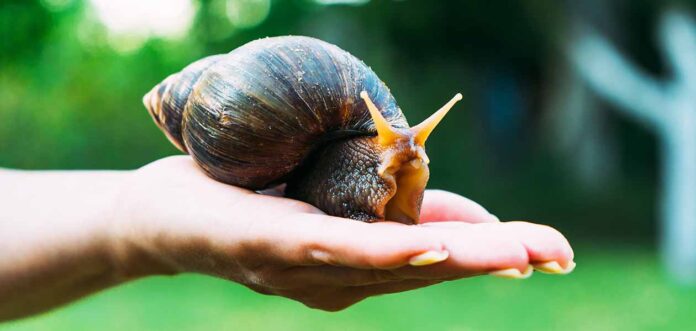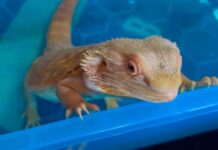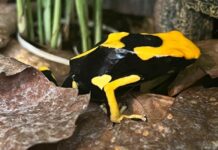The term giant African land snail describes several species of large snails.
They can reach up to a foot long, and for some people they make fascinating and unusual pets.
But giant African land snails are a dangerous invasive species when released into the wild. So, many regions have laws forbidding keeping them in captivity.
You must check the laws where you live before bringing home one of these interesting pets.
In This Guide
In this article, we’ve got loads of interesting facts and information about giant African land snails.
Whether you’re interested in owning one, or unfortunately that isn’t possible for you, there’s plenty to make it worth your while.
If you’d like to navigate to specific topics, you can use the links below.
- Types of giant African land snail
- How big to giant African land snails get?
- Giant African land snail facts
- Giant African land snails as pets
- How long do giant African land snails live?
- Is a giant African land snail right for you?
Or, join us from start to finish for the full experience!
Let’s begin!
Introducing the Giant African Land Snail
Giant African land snails, also known as GALS, are surprising and exotic pets.
It’s fascinating to see something normally so small on such a massive scale.
But their shell isn’t their only outsized quality. They can cause destruction on a massive scale too!
Originally from (no surprises) Africa, GALS imported to other countries have enormous potential to become invasive species.
They can lay up to 500 eggs at a time, but their whopping size puts them beyond the reach of most predators.
Giant African Land Snail Destruction
Once grown up, these mega-molluscs devastate crops, and even damage buildings by gobbling the render to extract calcium for their shells.
For this reason, it’s illegal in the U.S. to own or transport a giant African land snail, and infestations discovered in the wild must be reported to the National Invasive Species Information Center.
But rather than getting bogged down in disappointment if you were hoping to own one, let’s find out more about the amazing invertebrate which earned so much fear and respect.
Types Of Giant African Land Snail
‘Giant African land snail’ is a handy descriptive term, but it doesn’t actually refer to one single species.
In fact several African land snail species are pretty huge.
But three in particular are best known in captivity:
- the East African land snail
- the West African land snail, also known as the banana rasp snail
- and the giant Ghana snail, also known as the tiger snail.
They are all closely related, and look broadly similar.
Appearances
They have conical shells, with stripes in shades of brown and black. And thick brown bodies.
In captivity, breeding strains with mutations that give them a distinctive appearance are especially popular.
For example, albino GALS like the one in this picture, which have white bodies and slightly paler shells.

How Big Do Giant African Land Snails Get?
Giant African land snail size depends on their species, and environmental factors such as access to calcium in their diet.
But they always live up to their name!
East African land snails reach 4 to 8 inches long.
But it’s a Ghana snail which holds the world record for the largest land snail specimen ever recorded.
The mighty mollusc, named Gee Geronimo, measured 15.5 inches from snout to tail,and weighed a full 2lbs.
It’s shell alone measured 10.75 inches from opening to tip.
Giant African Land Snail Facts
Not everyone can keep a giant African land snail as a pet (more on this in a moment), but everyone can impress their friends with some of these amazing snail facts:
- Most snail shells spiral from right to left. Only about 10% of snail shells spiral from left to right.
- Snail’s eye stalks are actually a type tentacle.
- As are the shorter stalks in front of their eye stalks – these are used to receive chemical and tactile information from their surroundings.
- Snails are hermaphroditic, which means every individual possesses both male and female appendages. And any two snails kept together can produce a clutch of fertile eggs.
Now let’s turn our attention back to GALS as pets.
Giant African Land Snails As Pets
In the wild, GALS live on forest floors, grazing on vegetation. But they also adapt well to life in captivity.
They are popular for people looking for a pet with a difference, petting zoos, and businesses offering animal encounter experiences to schools and parties.
Despite their sedentary image, giant African land snails are rather active, especially at dawn and dusk.
And they have a varied appetite, so owners can enjoy seeing which food they love, and which they accept more grudgingly.
However, the laws on keeping them vary by region:
- In the U.S. it is completely illegal to keep or transport all species of GALS.
- The same is true in Australia.
- In Canada, some species can be kept with a licence.
- And in the UK, GALS are legal as pets, but it is illegal to release (or their eggs) into the wild.
If you’re lucky enough to be allowed to keep a pet giant African snail in your region, what can you expect?
Keeping Giant African Land Snails
Giant African land snails need a glass or plastic tank, with ventilation holes and a secure lid.
In the bottom of the floor they need 3 – 6 inches of potting compost, soil or coir (fiber from the outer husk of a coconut).
Soil lifted from the back yard should be sterilized in a hot oven to kill off anything else already living in it.
Giant African land snails need a daytime temperature of between 77 and 86 degrees fahrenheit, depending on the species.
In most regions, this means using a heat mat to warm their tank.
Space and Diet
Their tank should contain clean branches large enough to climb on, and upturned pieces of bark or clay pot for them to hide beneath.
In the wild GALS consume over 500 different types of vegetation, so you can feed them almost anything from your salad drawer.
Finally, snails need a ready supply of calcium to promote healthy shell-growth. Usually, this means a piece of cuttlefish in the bottom of their tank.
You can read more about keeping snails as pets over here.
How Long Do Giant African Land Snails Live?
GALS live for approximately 5–8 years and some may even live to 10 years old!
And since they can’t be released into the wild, that means anyone bringing one home is setting themselves up for a long term commitment.
And modern understanding of whether snails experience pain suggests that we shouldn’t underestimate the importance of caring for them well in that time, and protecting their health.
Common health problems of GALS include:
Trauma
Snail shells are easily cracked or damaged by being dropped onto hard services.
Cracked shells can be reinforced with tissue paper and glue. Whilst small holes can be plugged with beeswax.
But whilst their shells are prone to damage, never attempt to euthanize a GALS by crushing it, or destroy one this way if you find it in the U.S.
For a start, it’s unlikely to be alone, so let professionals locate the infestation and handle it.
And secondly, that shell is tougher than you think – crushing is easily botched.
Calcium deficiency
GALS need calcium from sources like kale or cuttlefish in order to support health shell growth.
If they don’t receive enough, their shell will become thin and brittle and more vulnerable to damage.
Their size will also be stunted.
Snails living together may even try to cannibalize the shells of other snails.
Poisoning
GALS have voracious appetites, but vegetation from the yard can make them sick if it has been treated with fertilizers or pesticides.
Store bought salad leaves are a popular and palatable option for pet giant African snails, but they should be washed carefully and checked for slug pellets before adding them to your snail’s tank.
Parasites and disease
Giant African land snails can carry salmonella, and internal parasites which cause meningitis in humans.
To protect yourself, always wash your hands after handling one.
They can also carry ectoparasites, such as mites living on their shells.
Is A Giant African Land Snail The Right For You?
A giant African land snail is a surprisingly charismatic pet.
Once a suitable habitat has been established for them, they are also relatively low maintenance.
However, there are strict restrictions on owning them in many regions, due to the risk escaped or released snails pose to crops and local biodiversity.
So for most of us, this gastropod remains out of reach.
Do you have a pet giant African land snail?
How did you come to own such an unusual pet? What did you name them?
Tell us about them in the comments box down below!
References And Further Reading
- U.S. Department of Agriculture
- Braun et al. Clinical Techniques of Invertebrates. Veterinary Clinics: Exotic Animal Practice. 2006.
- Gilbertson & Wyatt. Evaluation of Euthanasia Techniques for an Invertebrate Species, Land Snails (Succinea putris). Journal of the American Association for Laboratory Animal Science. 2016.
- O’Brien. Dealing with giant African land snails. Vet Times. 2009.
- Pellett & O’Brien. Giant African Land Snails. Handbook of Exotic Pet Medicine. 2020.
- Achatina fulica (giant African land snail) Datasheet. Centre for Agriculture and Bioscience International. Accessed October 2020.
- Guiness World Records. Accessed October 2020.















